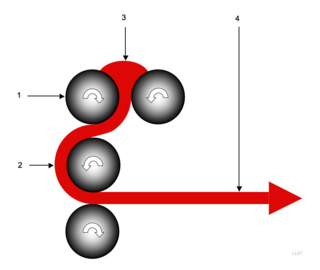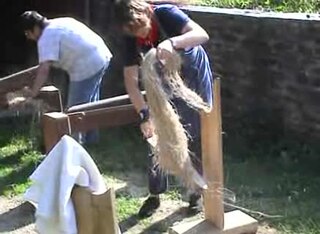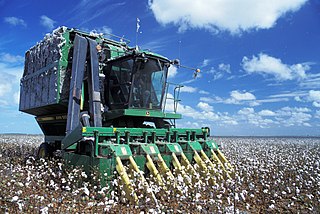Spinning is the twisting together of drawn-out strands of fibers to form yarn, and is a major part of the textile industry. The yarn is then used to create textiles, which are then used to make clothing and many other products. There are several industrial processes available to spin yarn, as well as hand-spinning techniques where the fiber is drawn out, twisted, and wound onto a bobbin.
This timeline of clothing and textiles technology covers the events of fiber and flexible woven material worn on the body; including making, modification, usage, and knowledge of tools, machines, techniques, crafts, and systems (technology).

Cashmere wool, usually simply known as cashmere, is a fiber obtained from cashmere goats or pashmina goats and other types of goat. The word cashmere is an old spelling of Kashmir.

A hole punch most commonly refers to an office tool that is used to create holes in sheets of paper, often for the purpose of collecting the sheets in a binder or folder. The term can also refer to tools of different construction from one designed for paper, such as a those used for leather goods, for cloth, for thin plastic sheeting, and for variations of sheet metal, such as aluminum siding or metal air ducts.

A calender is a series of hard pressure rollers used to finish or smooth a sheet of material such as paper, textiles, or plastics. Calender rolls are also used to form some types of plastic films and to apply coatings. Some calender rolls are heated or cooled as needed. Calenders are sometimes spelled calendars.
Textile manufacturing is a major industry. It is based on the conversion of fiber into yarn, yarn into fabric. These are then dyed or printed, fabricated into clothes. Different types of fibers are used to produce yarn. Cotton remains the most important natural fiber, so is treated in depth. There are many variable processes available at the spinning and fabric-forming stages coupled with the complexities of the finishing and colouration processes to the production of a wide ranges of products. There remains a large industry that uses hand techniques to achieve the same results.

Qiviuq [sg] or qiviut [pl] is the inner wool of the muskox. In Inuktitut the same word can be used to refer to the down feathers of birds.

The spinning mule is a machine used to spin cotton and other fibres. They were used extensively from the late 18th to the early 20th century in the mills of Lancashire and elsewhere. Mules were worked in pairs by a minder, with the help of two boys: the little piecer and the big or side piecer. The carriage carried up to 1,320 spindles and could be 150 feet (46 m) long, and would move forward and back a distance of 5 feet (1.5 m) four times a minute. It was invented between 1775 and 1779 by Samuel Crompton. The self-acting (automatic) mule was patented by Richard Roberts in 1825. At its peak there were 50,000,000 mule spindles in Lancashire alone. Modern versions are still in niche production and are used to spin woollen yarns from noble fibres such as cashmere, ultra-fine merino and alpaca for the knitware market.

In metalworking, rolling is a metal forming process in which metal stock is passed through one or more pairs of rolls to reduce the thickness and to make the thickness uniform. The concept is similar to the rolling of dough. Rolling is classified according to the temperature of the metal rolled. If the temperature of the metal is above its recrystallization temperature, then the process is known as hot rolling. If the temperature of the metal is below its recrystallization temperature, the process is known as cold rolling. In terms of usage, hot rolling processes more tonnage than any other manufacturing process, and cold rolling processes the most tonnage out of all cold working processes. Roll stands holding pairs of rolls are grouped together into rolling mills that can quickly process metal, typically steel, into products such as structural steel, bar stock, and rails. Most steel mills have rolling mill divisions that convert the semi-finished casting products into finished products.

Cotton-spinning machinery refers to machines which process prepared cotton roving into workable yarn or thread. Such machinery can be dated back centuries. During the 18th and 19th centuries, as part of the Industrial Revolution cotton-spinning machinery was developed to bring mass production to the cotton industry. Cotton spinning machinery was installed in large factories, commonly known as cotton mills.

Thomas Highs (1718–1803), of Leigh, Lancashire, was a reed-maker and manufacturer of cotton carding and spinning engines in the 1780s, during the Industrial Revolution. He is known for claiming patents on a spinning jenny, a carding machine and the throstle.

Combing is a method for preparing carded fiber for spinning. Combing is divided into linear and circular combing. The Noble comb is an example of circular combing. The French comb is an example of linear combing. The process of combing is accompanied by gilling, a process of evening out carded or combed top making it suitable for spinning. Combing separates out short fibers by means of a rotating ring or rectilinear row of steel pins. The fibers in the 'top' it produces have been straightened and lie parallel to each other. When combing wool, the discarded short fibers are called noils, and are ground up into shoddy.
Decatising or decatizing, also known as crabbing, blowing, and decating, is the process of making permanent a textile finish on a cloth, so that it does not shrink during garment making. The word comes from the French décatir, which means to remove the cati or finish of the wool. Though used mainly for wool, the term is also applied to processes performed on fabrics of other fibers, such as cotton, linen or polyester. Crabbing and blowing are minor variations on the general process for wool, which is to roll the cloth onto a roller and blow steam through it.
Textile manufacturing is one of the oldest human activities. The oldest known textiles date back to about 5000 B.C. In order to make textiles, the first requirement is a source of fibre from which a yarn can be made, primarily by spinning. The yarn is processed by knitting or weaving to create cloth. The machine used for weaving is the loom. Cloth is finished by what are described as wet processes to become fabric. The fabric may be dyed, printed or decorated by embroidering with coloured yarns.

Ring spinning is a method of spinning fibres, such as cotton, flax or wool, to make a yarn. The ring frame developed from the throstle frame, which in its turn was a descendant of Arkwright's water frame. Ring spinning is a continuous process, unlike mule spinning which uses an intermittent action. In ring spinning, the roving is first attenuated by using drawing rollers, then spun and wound around a rotating spindle which in its turn is contained within an independently rotating ring flyer. Traditionally ring frames could only be used for the coarser counts, but they could be attended by semi-skilled labour.

Bradford Industrial Museum, established 1974 in Moorside Mills, Eccleshill, Bradford, United Kingdom, specializes in relics of local industry, especially printing and textile machinery, kept in working condition for regular demonstrations to the public. There is a Horse Emporium in the old canteen block plus a shop in the mill, and entry is free of charge.

Heckling is the last of three steps in dressing flax, or preparing the fibers to be spun. It splits and straightens the flax fibers, as well as removes the fibrous core and impurities. Flax is pulled through heckling combs, which parts the locked fibers and makes them straight, clean, and ready to spin. After heckling flax is ready to be woven into linen.
Doubling is a textile industry term synonymous with combining. It can be used for various processes during spinning. During the carding stage, several sources of roving are doubled together and drawn, to remove variations in thickness. After spinning, yarn is doubled for many reasons. Yarn may be doubled to produce warp for weaving, to make cotton for lace, crochet and knitting. It is used for embroidery threads and sewing threads, for example: sewing thread is usually 6-cable thread. Two threads of spun 60s cotton are twisted together, and three of these double threads are twisted into a cable, of what is now 5s yarn. This is mercerised, gassed and wound onto a bobbin.
Yarn engineering is the process of constructing yarn using procedures designed to change its properties. The purpose of yarn engineering is to optimize the performance and minimize the cost of textile products through the process of selecting the most effective raw materials, fiber type, manufacturing method, and yarn structure[1].






















